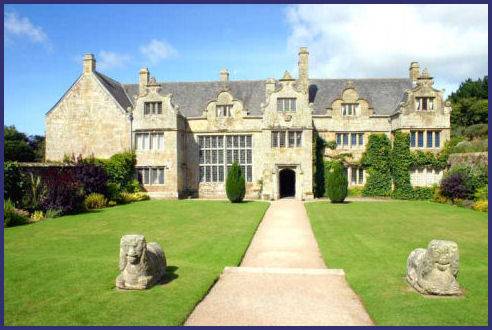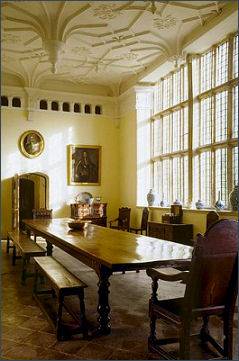Trerice
OS grid reference - SW 840 584
 The Elizabethan manor house of Trerice is situated at Kestle Mill, three miles from the town of Newquay, the house is noted for its fine plasterwork and a continental gable design that may be unique for its period.
The Elizabethan manor house of Trerice is situated at Kestle Mill, three miles from the town of Newquay, the house is noted for its fine plasterwork and a continental gable design that may be unique for its period.
The Arundells inherited Trerice through marriage around 700 years ago and were seated at Trerice at least as early as the reign of Edward III. Sir John Arundell (died 15 September 1580) inherited the estate from his father, also Sir John, who was Esquire of the Body to King Henry VIII and recieved a knighthood from him after the battle of the Spurs.
When Sheriff of Cornwall Sir John Arundel was sent by King Edward IV to retake St. Michael's Mount, which had been seized by the Earl of Oxford. Legend states that Sir John had moved from Efford, by the sea, to Trerice owing to a prophecy that 'he would be slain in the sands.' Yet the move does not seem to have averted his fate, the was killed near Marazion in 1471 in a skirmish, his remains lie in the chapel of St. Michael's Mount.
The outstanding member of the family was his grandson, Sir John Arundell of Trerice (c.1495-1560), who was born at Efford near Bude. A contentious and lively figure, he improved the family fortunes by his marriages and served four monarchs. He earned praise for the capture of Duncan Campbell, a Scottish pirate in a sea battle, while in 1537 he confronted Spanish ships which were attempting to pursue French men-of-war up the Truro River. In 1542 he was knighted and made vice-admiral of the west for the future Edward VI, who rewarded him with lands and goods for his service against rebels. He investigated discontent in Cornwall with the boy-king's Edward VI's religious policies and mustered troops in case of invasion. On his death, on 25 or 26 November 1560, Sir John held over 10,000 acres in Devon, Cornwall, and Somerset. An engraved tomb brass depicting him with his wives and children lies at St Andrew's Church, Stratton, near Efford.
 The house was rebuilt by Sir John Arundel in 1572 on the site of an medieval house, Sir John's income had been boosted ten years earlier by marrying well. By the sixteenth century the family had become well-established and was connected by marriage to nearly all the other landed families in Cornwall. Sir John Arundell of Trerice was predeceased by his eldest son, Roger, and this gave rise to problems of inheritance. Sir John was succeeded by his grandson John Arundell of Gwarnack (1557-1613).
The house was rebuilt by Sir John Arundel in 1572 on the site of an medieval house, Sir John's income had been boosted ten years earlier by marrying well. By the sixteenth century the family had become well-established and was connected by marriage to nearly all the other landed families in Cornwall. Sir John Arundell of Trerice was predeceased by his eldest son, Roger, and this gave rise to problems of inheritance. Sir John was succeeded by his grandson John Arundell of Gwarnack (1557-1613).
During the Civil War another Sir John Arundell VI, son of the builder of Trerice, was the commander of Pendennis Castle at Falmouth for Charles I. The family recovered their position after the Restoration of the Monarchy, following the restoration of King Charles II, Richard Arundell became Baron Arundell in recognition of the support he and his father had given Charles I.
The Arundell line died out in 1768 with death of the fourth baron, John, and the house passed to Sir Thomas Dyke Acland of the Acland family of Killerton in Devon. In 1953 Trerice became the property of the National Trust. The wide front of the building is impressive with a Dutch gabled facade, which is unusual in Cornwall and probably reflects Sir John Arundell's service in the Low Countries for Queen Elizabeth I.
The house boasts a collection of high quality English furniture, clocks, needlework and Stuart portraits. The Great Hall boasts an elaborate plaster ceiling and a minstrel's gallery. The drawing room on the first floor has an elaborate overmantel. The hay loft in the Great Barn sets out in intriguing detail the part played by its owners in the time of King Henry VIII and in the English Civil War.
The gardens have an old Cornish apple orchard, they contain many rare and unusual plants, shrubs and climbers and a collection of lawnmowers. There is a shop at Trerice, plant sales and a museum.
Image 1 courtesy of Cornwall Digital
Historic Buildings in Cornwall